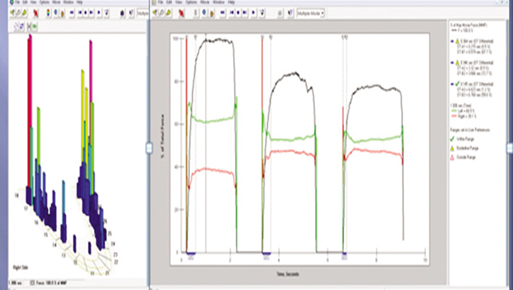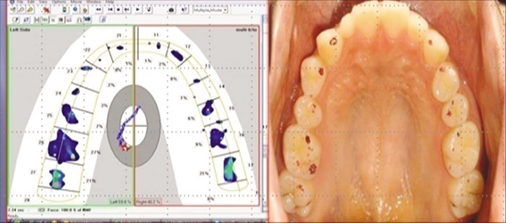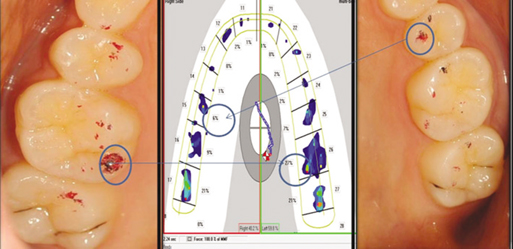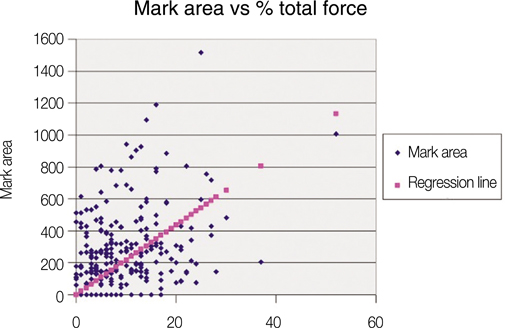J Adv Prosthodont.
2012 Feb;4(1):7-12. 10.4047/jap.2012.4.1.7.
Relationship between articulation paper mark size and percentage of force measured with computerized occlusal analysis
- Affiliations
-
- 1Department of Prosthodontics, Graduate School of Clinical Dentistry, Korea University Guro Hospital, Seoul, Korea.
- 2Department of Restorative Dentistry, School of Dental Medicine, Tufts University, Boston, Massachusetts, USA.
- 3Department of Conservative Dentistry, Seoul National University Dental Hospital, Seoul, Korea.
- 4Department of Prosthodontics, School of Dentistry, Pusan National University, Yangsan, Korea.
- 5Deptatment of Prosthodontics, Korea University Guro Hospital, Seoul, Korea. swshin@korea.ac.kr
- KMID: 2284777
- DOI: http://doi.org/10.4047/jap.2012.4.1.7
Abstract
- PURPOSE
Articulation paper mark size is widely accepted as an indicator of forceful tooth contacts. However, mark size is indicative of contact location and surface area only, and does not quantify occlusal force. The purpose of this study is to determine if a relationship exists between the size of paper marks and the percentage of force applied to the same tooth.
MATERIALS AND METHODS
Thirty dentate female subjects intercuspated into articulation paper strips to mark occlusal contacts on their maxillary posterior teeth, followed by taking photographs. Then each subject made a multi-bite digital occlusal force percentage recording. The surface area of the largest and darkest articulation paper mark (n = 240 marks) in each quadrant (n = 60 quadrants) was calculated in photographic pixels, and compared with the force percentage present on the same tooth.
RESULTS
Regression analysis shows a bi-variant fit of force % on tooth (P<.05). The correlation coefficient between the mark area and the percentage of force indicated a low positive correlation. The coefficient of determination showed a low causative relationship between mark area and force (r2 = 0.067). The largest paper mark in each quadrant was matched with the most forceful tooth in that same quadrant only 38.3% of time. Only 6 2/3% of mark surface area could be explained by applied occlusal force, while most of the mark area results from other factors unrelated to the applied occlusal force.
CONCLUSION
The findings of this study indicate that size of articulation paper mark is an unreliable indicator of applied occlusal force, to guide treatment occlusal adjustments.
Figure
Cited by 1 articles
-
Clinical Decision Support Model to Predict Occlusal Force in Bruxism Patients
Bhornsawan Thanathornwong, Siriwan Suebnukarn
Healthc Inform Res. 2017;23(4):255-261. doi: 10.4258/hir.2017.23.4.255.
Reference
-
1. Schelb E, Kaiser DA, Brukl CE. Thickness and marking characteristics of occlusal registration strips. J Prosthet Dent. 1985. 54:122–126.2. Halperin GC, Halperin AR, Norling BK. Thickness, strength, and plastic deformation of occlusal registration strips. J Prosthet Dent. 1982. 48:575–578.3. Millstein P, Maya A. An evaluation of occlusal contact marking indicators. A descriptive quantitative method. J Am Dent Assoc. 2001. 132:1280–1286.4. Carey JP, Craig M, Kerstein RB, Radke J. Determining a relationship between applied occlusal load and articulating paper mark area. Open Dent J. 2007. 1:1–7.5. Saad MN, Weiner G, Ehrenberg D, Weiner S. Effects of load and indicator type upon occlusal contact markings. J Biomed Mater Res B Appl Biomater. 2008. 85:18–22.6. Carossa S, Lojacono A, Schierano G, Pera P. Evaluation of occlusal contacts in the dental laboratory: influence of strip thickness and operator experience. Int J Prosthodont. 2000. 13:201–204.7. Millstein P. Know your indicator. J Mass Dent Soc. 2008. 56:30–31.8. Gazit E, Fitzig S, Lieberman MA. Reproducibility of occlusal marking techniques. J Prosthet Dent. 1986. 55:505–509.9. Glickman I, Carranza FA Jr. Glickman's clinical periodontology: Prevention, diagnosis, and treatment of periodontal disease in the practice of general dentistry. 1979. 5th ed. Philadelphia: WB Saunders Co.;951.10. McNeill C. Science and practice of occlusion. 1997. IL: Quintessence publishing;421.11. Okeson JP. Management of temporomandibular disorders and occlusion. 2003. 5th ed. St. Louis: Mosby;416. 418. 605.12. Kleinberg I. Occlusion practice and assessment. 1991. Oxford (UK): Knight publishing;128.13. Smukler H. Equilibration in the natural and restored dentition. 1991. Chicago, IL: Quintessence publishing Co.;110.14. Dawson PE. Functional occlusion: From TMJ to smile design. 2007. St. Louis, Mo.: Mosby;47.15. Kerstein RB, Lowe M, Harty M, Radke J. A force reproduction analysis of two recording sensors of a computerized occlusal analysis system. Cranio. 2006. 24:15–24.16. Kerstein RB, Radke J. The effect of disclusion time reduction on maximal clench muscle activity levels. Cranio. 2006. 24:156–165.17. Kerstein RB. Reducing chronic masseter and temporalis muscular hyperactivity with computer-guided occlusal adjustments. Compend Contin Educ Dent. 2010. 31:530–534. 536538 passim
- Full Text Links
- Actions
-
Cited
- CITED
-
- Close
- Share
- Similar articles
-
- Clinical Decision Support Model to Predict Occlusal Force in Bruxism Patients
- Occlusal force evaluation and its clinical implication in dental clinics
- Comparisons of occlusal force according to occlusal relationship, skeletal pattern, age and gender in Koreans
- A Reproducible and Reliable Method for Measuring Masseter Muscle Thickness in Maximal Bite Force Using Ultrasonography
- Comparison of maximum occlusal forces on osseointegrated implant supported fixed prostheses and natural teeth






